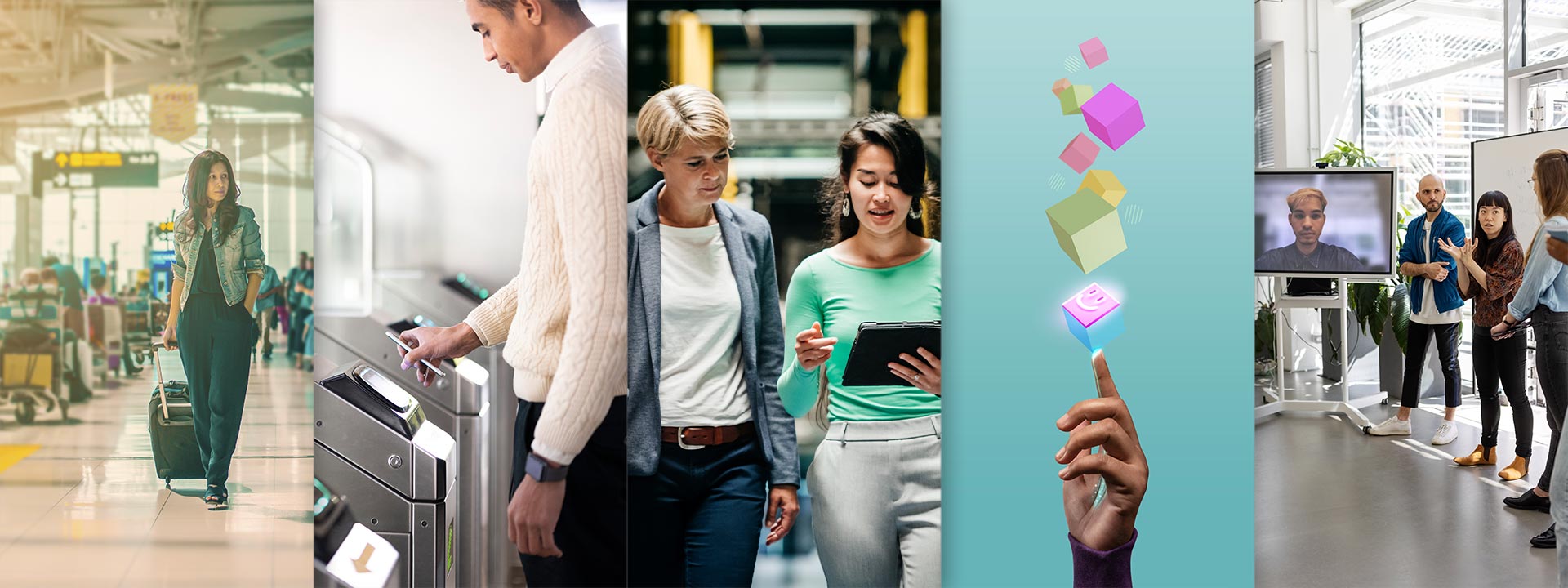

2022 was, in many ways, a transitional year. Thankfully, much of the world transitioned away from months of lockdowns to a slowly-but-surely evolving new normal. We’ve transitioned from fully remote work to new, hybrid models, from a booming economic recovery to a great deal of near-term economic uncertainty, and the global transition from cash to digital payments continues. As we look ahead to 2023, here are five trends in the payments landscape we’re watching closely.
1. For business and pleasure, travel returns, fueling retail spend
Throughout 2022, global travel has rebounded, helped in large part by border re-openings releasing pent-up demand in region after region, something we expect to continue into 2023 (with Asia Pacific now relaxing its controls as well). Recent research from Visa¹ found a broad-based increase in the average amount spent per traveler while abroad between June and August of this year, a fact that held true for both retail and traditional travel categories like hotels, restaurants and entertainment. Initially fueled by more affluent travelers and extended vacations, growth in both cross-border retail spending and other non-retail travel spend has evened out as the mix of travelers broadens and trip durations return to normal.
While business travel has partially resumed, some tourists are taking advantage of travel deals in less-than-packed business destinations, paying less per hotel stay in seven out of every 10 business destination cities globally, compared to 2019 levels.¹ Even as the travel recovery continues and business destinations gain ground, tourist deals in business-friendly cities will persist, with hotels and travel businesses maintaining the same higher pricing for business travelers while leveraging discounted rates for leisure travelers to make up the difference in remaining availability.
With some borders still yet to open — namely China — there’s likely still growth in travel and related retail spending to come. Visa’s data found that shopping by foreign tourists had fully recovered in 63% of the top 500 destinations that were the most visited prior to the pandemic – a number that is likely to grow in 2023.
2. Consumers more purposeful, conscious in choosing sustainable behaviors
While this year will see more people leaving home for work, leisure, and everything in between, consumers are centering concerns about sustainability and climate change in their behaviors and consumption patterns. According to a recent study from Skift and McKinsey, 40% of travelers globally were willing to pay at least 2% more on carbon-neutral flight tickets. So far, that same data shows that only 14% of travelers have actually done so. In 2023, we expect to see more consumers walk the talk as more options become available. Offerings like the Visa Eco Benefits bundle and partnership with Ecolytiq are giving consumers benefits like climate awareness and carbon footprint calculations, helping them make more informed and sustainable choices at the checkout. Recommerce — another phrase for circular commerce, where Rental, Refill, Repair, Resale, Returning and Redistributing goods make for more sustainable choices — is also gaining in popularity, with 69% of consumers who participated in a recent Visa survey saying they would choose retailers based on Recommerce activities.¹ In the year ahead, we expect more card rewards for consumers who make sustainable choices and tools that help consumers visualize their impact when making plans.
Convenience, too, will play a key role in helping consumers make sustainable choices in their daily lives. For instance, the ability to pay for public transit using a contactless credit, debit or prepaid card, or payment enabled device means people no longer need to tie up funds on a designated transit card, paper ticket, or fumble for cash when opting against driving. Visa’s second Future of Urban Mobility survey found that an overwhelming 91% of riders now expect contactless payments to be part of their transit experience. Looking ahead, we expect contactless fare payment to become the standard for public transportation — delivering a more inclusive, efficient, and sustainable transit experience for both riders and operators. And with Visa’s network surpassing one billion tap-to-ride transactions on global transit systems in just ten months in 2022, closing out the fiscal year with more than 1.2 billion, we see no signs of slowing down.
3. B2B goes 3.0
Innovation within the B2B payments industry will fuel another wave of digital transformation. In 2023 and beyond, we’ll see a 3.0 version of B2B Payments — one where the new frontier of global B2B commerce is all digital, secure, fast, flexible and seamless. We’ll see a rise in B2B mobile payments, as the preference for businesses to be able to pay and be paid by phone increases, and B2B payments digitization will fuel increases in B2B ecommerce purchases.
More B2B businesses than ever are now providing online payments, and 80% of B2B transactions are expected to be digital by 2025. The digitization of business process will continue to accelerate B2B transactions and integrated payment offerings beyond paper cheques and invoices. Accounts receivable teams are already seeing the benefits of sending electronic invoices and receiving digital payments. More and more governments are making progress in payments digitization, whether in the form of disbursements to citizens or to and from agencies as clients. Banks, processors, and networks continue to make progress against potential use cases for virtual cards. The flywheel of innovation will continue as the ecosystem provides more features and functionality to streamline business payments and operations.
4. During crypto winter, builders build
Crypto markets have seen their fair share of volatility over the past year. While the future remains to be seen, during the current crypto winter, we expect a number of less durable concepts to fall to the wayside, while others focused on taking a measured, compliant approach to new technological development will continue to build meaningful web3 solutions for businesses and consumers. In the fallout from recent liquidity failures, we are hopeful that crypto platforms around the globe take efforts to ensure that the right protections and customer disclosures are in place.
In the immediate future, we are seeing continued focus by governments, central banks, traditional financial institutions and fintechs on programmable money and payments — whether for CBDC, stablecoins or other forms of tokenized fiat money. Meaningful web3 payment use cases on the horizon include streaming payrolls, streaming micropayments and cross border disbursement.
Lastly, we are seeing brands leverage NFT technology to build new digital experiences, unlocking potential for new commerce, payments, and loyalty use cases. These experiences are often centered on the creation of unique avatars, digital items accompanying physical ones and vice versa, and loyalty platforms. In the coming year, we expect this trend to accelerate as brands look to deepen their relationships and engagements with their customers. This has the potential to unlock new commerce, payments, rewards, or loyalty experiences between consumers and brands.
5. Fraud adapts to a “hybrid” world
As more and more of the world adopts a “hybrid” work-lifestyle, fraudsters are keeping pace, adapting their tactics to where we are and aren’t and finding new ways to scam consumers. And with more travelers paying for flights, hotels, food, and making all sorts of purchases along the way, fraudsters have more opportunities to gain access to sensitive data. With travel quickly returning, we’ll likely continue to see an increase in cross-border fraud. One recent Visa poll found that more than half (58%) of travelers reported being concerned about the possibility of fraud on their credit or debit cards while traveling.²
Perhaps the newest threat to emerge is synthetic IDs — when fraudsters assemble a net new persona from fragments of ID components. We expect small businesses to continue to be targets, as they often don’t have the resources or know-how to prioritize security tools and other safeguards.
All of this together means that security and trust will remain critical. Next-generation authentication breakthroughs in user protection like EMV 3D Secure (EMV 3DS) are helping to make global eCommerce secure in real-time. Digital payment methods and solutions like virtual cards will continue to make it easier and more secure to do everything from purchase plane tickets to split the check at dinner. Businesses will also become more aware of the importance of investing in security tools to prevent fraud and insurance policies that could help mitigate the impact of a breach.
A world in transition
While the transition to digital is well underway — and accelerated during the pandemic years — many are still left out, including the 29% of adults in the developing world outside the formal financial system, and the 43% of adults in emerging economies who rely solely on cash.³ With 70% of the new value created in the global economy to be based on productivity gains from digital technology adoption, there’s still much work to do.³
- https://images.globalclient.visa.com/Web/InovantElqVisaCheckout/%7Bd3ff33c3-7b67-4e73-b354-4e615c3ad814%7D_Global_Travel_Insight_Q3-2022_FINAL.pdf
- Based on research commissioned by Visa and conducted by Opinium and Globescan with SMBs and consumers across Europe, as well as from The Circularity Gap Report, 2021
- https://corporate.visa.com/content/dam/VCOM/corporate/visa-perspectives/travel-and-insights/documents/veei-digital-equity-framework.pdf